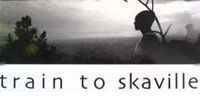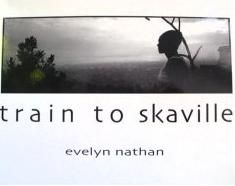
pil·grim ( ) (plgrm)n.
1. A religious devotee who journeys to a shrine or sacred place.
2. One who embarks on a quest for something conceived of as sacred.
3. A traveler.
4. Pilgrim One of the English Separatists who founded the colony of
Plymouth in New England in 1620.
[Middle English, from Old French peligrin, from Late Latin pelegrnus,
alteration of Latin peregrnus, foreigner. See peregrine.]
Buried in the first half of Evelyn Nathan’s compact book of poems and photography is the short poem “Pilgrim,” accompanied by a photograph that seems mundane but oddly disorienting at the same time. The poem is a dense little verse, deceptively straightforward but contains clues about Ms. Nathans lifelong history with Jamaica. It speaks of distant birthlands, spiritual rebirths and cross-pollination between peoples and cultures, and ends with the speaker comparing herself to a spore on the wind. Clearly this is a reference to artist herself, who came to Jamaica in the 70’s to teach photography in Kingston and started distilling her experiences into art, both hers and that of her students. [According to the photographic credits, some of the images featured in the book are those of her former student Robin Lai.] The symbolism of the spore — as in human Diaspora — eloquently describes her life and art, particularly her need for understanding the contrasts between her two very
different cultures. And that accompanying photo, like the “hard, familiar faces” of the poem, turns out to be taken from a plane looking out over the turbine and into the clouds over the Caribbean. It is taken from the spore’s eye view, as it were, and nicely encapsulates Ms. Nathan’s lifelong relationship with Jamaica.
Or perhaps the photo is from a peregrine’s aerial perspective….My thoughts rewind to an anecdote from a friend in New York. A music lawyer and journalist by trade, he has a lifelong love of all popular music forms going back to the 60’s and an encyclopedic command of music trivia. The story is about a radio phenomenon called “skip. “ “Skip” is a radio term that describes the fact that sometimes AM radio waves skip across the atmosphere, like a flat stone skipping across the surface of a lake, so that, depending on weather conditions, you can sometimes hear AM signals from really distant locations. When my buddy was a kid he would sit at night with an AM radio, turning the dial very slowly to see what stations he could get…distant stations in other
cities being the ultimate prize…..and on different nights he could hear different ones. And, not surprisingly, Jamaican folks were doing the same thing. In pop music history, this bit of technical arcana served
as a veritable time machine, and has been important for the ongoing cultural dialogue it enabled between Jamaican and American musicians since the 60’s, whether it was ska and early reggae artists emulating
James Brown’s funky syncopation, or the pioneering rap producer DJ Kool Herc using the free-form singing/rhyming style of dub style reggae of U-Roy and I-Roy popular in Kingston dance-halls. Like the skip
phenomenon, Ms. Nathan’s poems and images are surprisingly transporting, allowing the reader to immerse herself – or literally tune into — details of distant happenings and feelings.
This immersive quality is the same in great paintings…my mind moves to word paintings. In a famous interview he gave to The Paris Review in 1999 about the art of theater, the late poet and playwright August
Wilson was asked about the process by which he distills stage-play from the raw material of a concept or image. He says that he imagines a scene –say a train station with clusters of people in different parts of the
waiting room. And then he asks himself a series of questions about each individual character and how they may relate to each other in that space –Who is she? Why is she in the station? Where is she going? Has she
seen the guy in the corner? If so, how did they look at each other? How long did they hold the gaze?, etc. Then, what he finds is that after enough of these questions are asked and answered there’s a Eureka Moment when
he feels: I can truly SEE this!!
As a transplanted Caribbean native (from Trinidad), this is very similar to what I felt looking at Ms. Nathan’s photography for the first time. The reaction didn’t make sense to me really until I saw first hand how
the work affects other Caribbeans, especially Jamaicans. This below is from my sister-in-law, Marcia Moss Heraman, a highly intuitive person and a first generation Jamaican-American:
I personally had a very visceral response that may not be relevant to someone else. I saw a certain understanding and respect for the dignity of the culture and the people that’s not often conveyed. I saw layers
of generations of me. I saw grace, depth and honesty, mixed with the pride and strength of a Maroon. I saw me yesterday and tomorrow as I saw my daughter and my mother. I thought to myself : When you bare your soul,
your hope is that you are heard, and I believe that this artist not only heard, but spoke the same language.
Wow—if that’s not a word painting in the Wilsonian sense, I don’t know what is! I suspect that Ms. Nathan’s work will have this effect on many people, and to some extent all Caribbeans. Its as if she’s given us
the scene, and then with her keenly observed visual and emotional details helped us to answer those intimate questions that speak to what is important, what is universal about ourselves and the places from whence we Caribbeans hail.










